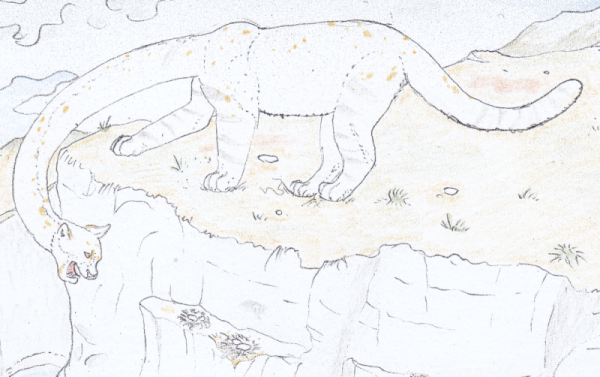Serpopards
High cyclopean: Kúfa /khuːɸa/
North low cyclopean: Pof /phɔːf/
Serpopards1 are carnivorous mammals native to the northern lowlands and central highlands of the continent of Lúrk, Borgalor's smallest continent.
North low cyclopean: Pof /phɔːf/
Serpopards1 are carnivorous mammals native to the northern lowlands and central highlands of the continent of Lúrk, Borgalor's smallest continent.
Basic Information
Anatomy
The head and body of a serpopard somewhat resembles that of our world's mountain lions, though with a much longer neck or about the length of the rest of its body, which allows it to catch fish, birds or young Equine- and Suine Hippalektryons without too much exertion or getting wet. While the neck is flexible and capable of extremely quick reflexes, the animal moves otherwise sluggishly and only capable of quick sprinting to escape danger.
Like the local Cyclopes, serpopards have innate ability to use shock magic, which they unleash via biting either to stun prey or when fighting over food and shelter.
Like the local Cyclopes, serpopards have innate ability to use shock magic, which they unleash via biting either to stun prey or when fighting over food and shelter.
Dietary Needs and Habits
Serpopard diet varies depending on their environment, with those found in the highlands subsisting mostly on fish and young equine hippalektryons, while on the lowlands they feed on suine hippalektryon piglets or more commonly birds, either by snatching ones that fly too close or reaching for eggs and chicks on rock ledges or in nests.
Behaviour
While serpopards tolerate each other's presence, the animals mostly keep to themselves outside of mating season or when there's plenty of food, such as when encountering carcasses of elephant seals, whales or sea serpents. Only the females take care of the young, usually two to four per litter, keeping them in a natural shelter at first until they are able to follow her around and gradually learn to fend for themselves.
They become adults around two and a half years old.
They become adults around two and a half years old.
Additional Information
Uses, Products & Exploitation
The cyclopes who inhabit Lúrk have mixed feelings about serpopards, with many finding the creatures beautiful but also regard them as pests for attacking domesticated hippalektryons. However, the animals have an innate fear of cyclopes and people in general, and only attack them if cornered, so simply keeping watch over the livestock is enough to keep serpopards at bay.
The beasts are a popular attraction in zoos, where their enclosures are often equipped with fish ponds for feeding.
The beasts are a popular attraction in zoos, where their enclosures are often equipped with fish ponds for feeding.
1Original icelandic: glefsar, singular: glefsir.
Origin/Ancestry
Lúrk
Lifespan
About a decade in the wild, twice as long in captivity
Average Weight
70 kg
Average Length
3-3.5m
Body Tint, Colouring and Marking
The coat is off-white with grey stripes and small, irregular golden spots, allowing the animal to camouflage against Lúrk's white cliffs




Comments